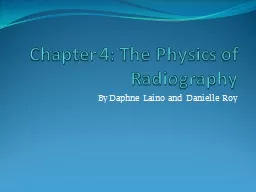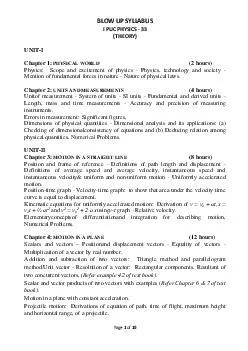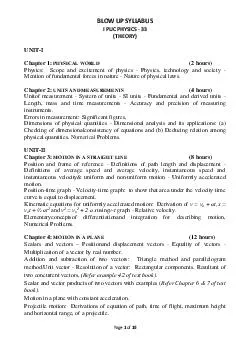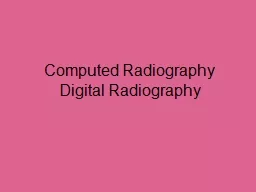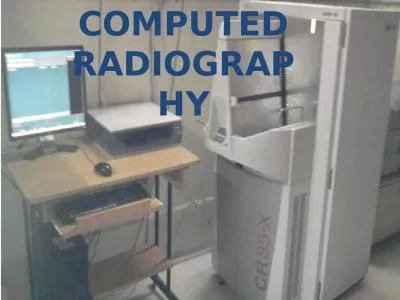PPT-Chapter 4: The Physics of Radiography
Author : briana-ranney | Published Date : 2016-12-13
By Daphne Laino and Danielle Roy The Physics of Radiography Two basic types of xray imaging modalities projection radiography and computed tomography Neither modality
Presentation Embed Code
Download Presentation
Download Presentation The PPT/PDF document "Chapter 4: The Physics of Radiography" is the property of its rightful owner. Permission is granted to download and print the materials on this website for personal, non-commercial use only, and to display it on your personal computer provided you do not modify the materials and that you retain all copyright notices contained in the materials. By downloading content from our website, you accept the terms of this agreement.
Chapter 4: The Physics of Radiography: Transcript
By Daphne Laino and Danielle Roy The Physics of Radiography Two basic types of xray imaging modalities projection radiography and computed tomography Neither modality involves radiation XRays. Welcome to Industrial Imaging Systems LLC, we have over twenty years of experience in 3D X-Ray, tomography scanner and Non Destructive Testing in San Jose.
Industrial Imaging Solutions provides Non Destructive Testing (NDT) solutions helping our customers make the transition to digital imaging. With over twenty years of industry experience, our Level III Engineers have been successfully converting inspection processes to digital inspection within a diverse base of customers and industries.
Chapter 2 UNITS AND MEASUREMENTS 4 hours Unitof measurement System of units SI units undamental and derived units Length mass and time measurements Accuracy and precision of measuring instruments rrors in measurement Significant figures Dimensions Chapter 2 UNITS AND MEASUREMENTS 4 hours Unitof measurement System of units SI units undamental and derived units Length mass and time measurements Accuracy and precision of measuring instruments rrors in measurement Significant figures Dimensions 1
Best Practices
In Digital Radiography
T
he amount of radiation Americans are exposed
to as a result of diagnostic medical imaging
increased about sixfold from 1980 to 2006, and
for the first ti Digital Radiography. Computed Radiography (CR). Been around since 1980-81. Uses same radiographic equipment. No change in X-ray machine. Uses an imaging plate. Contains a photostimulator phosphor. Need a cassette reader. D. . McLean . and J. Shepherd. of the IAEA publication . (. ISBN 978-92-0-131010-1):. Diagnostic Radiology Physics: . A Handbook for Teachers and Students . . Objective:. . To familiarize the student with Dental radiography, Mobile Radiography and fluoroscopy, Dual-Energy X-Ray absorptiometry, Conventional tomography and tomosynthesis. Purpose of the System. The purpose is to create a scanning system to determine the location and size of metal fragments in a medium density fiber panel.. Background Information. The Weapons Integration & Development Directorate of the US Army Aviation and Missile Research, Development, & Engineering Center performs a variety of munitions and warhead test programs. Define terminology relating to careers in medical imaging. Specify the role of diagnostic medical health care workers including personal characteristics, levels of education, and credentialing requirements. La gamme de thé MORPHEE vise toute générations recherchant le sommeil paisible tant désiré et non procuré par tout types de médicaments. Essentiellement composé de feuille de morphine, ce thé vous assurera d’un rétablissement digne d’un voyage sur . Website:certpot.com Website: www.certpot.com
Certification Dump: Prove Your Expertise in IT and Software Technologies
Certification dumps are collections of questions and answers used to prepare for a certification exam. They are often provided by third-party companies that specialize in exam preparation. Certification dumps are a valuable resource for anyone looking to prepare for a certification exam, as they provide an in-depth overview of the topics and concepts covered on the exam. Additionally, they are often updated with new and relevant information to ensure that the material is as fresh and up-to-date as possible. Certification dumps can save time and money by providing a comprehensive and convenient way to prepare for a certification exam. . D. entistry. . SEMMELWEIS. . UNIVERSITY. BUDAPEST. Department. of . Dentistry. . for. . Children. . and . Orthodontics. RADIOLOGY. the medical speciality, t. hat uses imaging to diagnose and treat diseases seen within the body;. Imaging system comprised of:. Photostimulable. Storage Phosphor. -to acquire the x-ray projection image. CR Reader. -to extract the electronic latent image. Digital electronics. -to convert the signals to digital form.
Download Document
Here is the link to download the presentation.
"Chapter 4: The Physics of Radiography"The content belongs to its owner. You may download and print it for personal use, without modification, and keep all copyright notices. By downloading, you agree to these terms.
Related Documents

